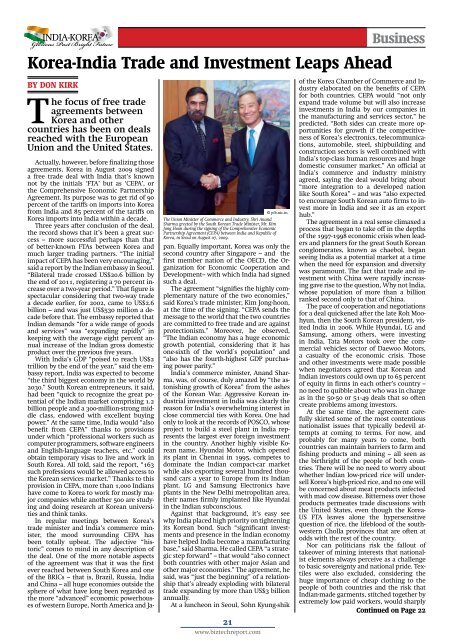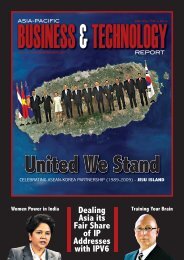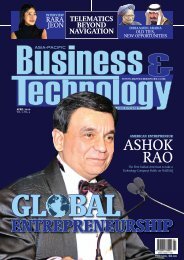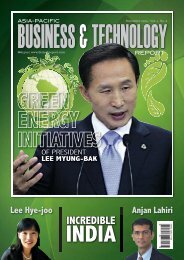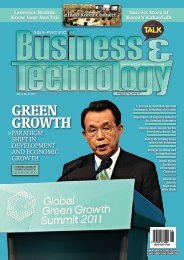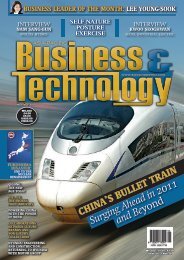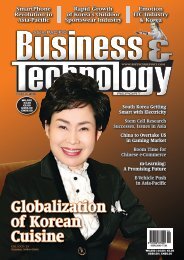INDIA-KOREA - Asia-Pacific Business and Technology Report
INDIA-KOREA - Asia-Pacific Business and Technology Report
INDIA-KOREA - Asia-Pacific Business and Technology Report
You also want an ePaper? Increase the reach of your titles
YUMPU automatically turns print PDFs into web optimized ePapers that Google loves.
<strong>INDIA</strong>-<strong>KOREA</strong><br />
Glorious Past Bright Future<br />
Korea-India Trade <strong>and</strong> Investment Leaps Ahead<br />
by Don Kirk<br />
The focus of free trade<br />
agreements between<br />
Korea <strong>and</strong> other<br />
countries has been on deals<br />
reached with the European<br />
Union <strong>and</strong> the United States.<br />
© pib.nic.in<br />
The Union Minister of Commerce <strong>and</strong> Industry, Shri An<strong>and</strong><br />
Sharma greeted by the South Korean Trade Minister, Mr. Kim<br />
Jong Hoon during the signing of the Comprehensive Economic<br />
Partnership Agreement (CEPA) between India <strong>and</strong> Republic of<br />
Korea, in Seoul on August 07, 2009.<br />
Actually, however, before finalizing those<br />
agreements, Korea in August 2009 signed<br />
a free trade deal with India that’s known<br />
not by the initials ‘FTA’ but as ‘CEPA’, or<br />
the Comprehensive Economic Partnership<br />
Agreement. Its purpose was to get rid of 90<br />
percent of the tariffs on imports into Korea<br />
from India <strong>and</strong> 85 percent of the tariffs on<br />
Korea imports into India within a decade.<br />
Three years after conclusion of the deal,<br />
the record shows that it’s been a great success<br />
– more successful perhaps than that<br />
of better-known FTAs between Korea <strong>and</strong><br />
much larger trading partners. “The initial<br />
impact of CEPA has been very encouraging,”<br />
said a report by the Indian embassy in Seoul.<br />
“Bilateral trade crossed US$20.6 billion by<br />
the end of 2011, registering a 70 percent increase<br />
over a two-year period.” That figure is<br />
spectacular considering that two-way trade<br />
a decade earlier, for 2002, came to US$2.6<br />
billion – <strong>and</strong> was just US$530 million a decade<br />
before that. The embassy reported that<br />
Indian dem<strong>and</strong>s “for a wide range of goods<br />
<strong>and</strong> services” was “exp<strong>and</strong>ing rapidly” in<br />
keeping with the average eight percent annual<br />
increase of the Indian gross domestic<br />
product over the previous five years.<br />
With India’s GDP “poised to reach US$2<br />
trillion by the end of the year,” said the embassy<br />
report, India was expected to become<br />
“the third biggest economy in the world by<br />
2030.” South Korean entrepreneurs, it said,<br />
had been “quick to recognize the great potential<br />
of the Indian market comprising 1.2<br />
billion people <strong>and</strong> a 300-million-strong middle<br />
class, endowed with excellent buying<br />
power.” At the same time, India would “also<br />
benefit from CEPA” thanks to provisions<br />
under which “professional workers such as<br />
computer programmers, software engineers<br />
<strong>and</strong> English-language teachers, etc.” could<br />
obtain temporary visas to live <strong>and</strong> work in<br />
South Korea. All told, said the report, “163<br />
such professions would be allowed access to<br />
the Korean services market.” Thanks to this<br />
provision in CEPA, more than 1,000 Indians<br />
have come to Korea to work for mostly major<br />
companies while another 500 are studying<br />
<strong>and</strong> doing research at Korean universities<br />
<strong>and</strong> think tanks.<br />
In regular meetings between Korea’s<br />
trade minister <strong>and</strong> India’s commerce minister,<br />
the mood surrounding CEPA has<br />
been totally upbeat. The adjective “historic”<br />
comes to mind in any description of<br />
the deal. One of the more notable aspects<br />
of the agreement was that it was the first<br />
ever reached between South Korea <strong>and</strong> one<br />
of the BRICs – that is, Brazil, Russia, India<br />
<strong>and</strong> China – all huge economies outside the<br />
sphere of what have long been regarded as<br />
the more “advanced” economic powerhouses<br />
of western Europe, North America <strong>and</strong> Japan.<br />
Equally important, Korea was only the<br />
second country after Singapore – <strong>and</strong> the<br />
first member nation of the OECD, the Organization<br />
for Economic Cooperation <strong>and</strong><br />
Development-- with which India had signed<br />
such a deal.<br />
The agreement “signifies the highly complementary<br />
nature of the two economies,”<br />
said Korea’s trade minister, Kim Jong-hoon,<br />
at the time of the signing. “CEPA sends the<br />
message to the world that the two countries<br />
are committed to free trade <strong>and</strong> are against<br />
protectionism.” Moreover, he observed,<br />
“The Indian economy has a huge economic<br />
growth potential, considering that it has<br />
one-sixth of the world`s population” <strong>and</strong><br />
“also has the fourth-highest GDP purchasing<br />
power parity.”<br />
India’s commerce minister, An<strong>and</strong> Sharma,<br />
was, of course, duly amazed by “the astonishing<br />
growth of Korea” from the ashes<br />
of the Korean War. Aggressive Korean industrial<br />
investment in India was clearly the<br />
reason for India’s overwhelming interest in<br />
close commercial ties with Korea. One had<br />
only to look at the records of POSCO, whose<br />
project to build a steel plant in India represents<br />
the largest ever foreign investment<br />
in the country. Another highly visible Korean<br />
name, Hyundai Motor, which opened<br />
its plant in Chennai in 1995, competes to<br />
dominate the Indian compact-car market<br />
while also exporting several hundred thous<strong>and</strong><br />
cars a year to Europe from its Indian<br />
plant. LG <strong>and</strong> Samsung Electronics have<br />
plants in the New Delhi metropolitan area,<br />
their names firmly implanted like Hyundai<br />
in the Indian subconscious.<br />
Against that background, it’s easy see<br />
why India placed high priority on tightening<br />
its Korean bond. Such “significant investments<br />
<strong>and</strong> presence in the Indian economy<br />
have helped India become a manufacturing<br />
base,” said Sharma. He called CEPA “a strategic<br />
step forward” – that would “also connect<br />
both countries with other major <strong>Asia</strong>n <strong>and</strong><br />
other major economies.” The agreement, he<br />
said, was “just the beginning” of a relationship<br />
that’s already exploding with bilateral<br />
trade exp<strong>and</strong>ing by more than US$3 billion<br />
annually.<br />
At a luncheon in Seoul, Sohn Kyung-shik<br />
21<br />
www.biztechreport.com<br />
<strong>Business</strong><br />
of the Korea Chamber of Commerce <strong>and</strong> Industry<br />
elaborated on the benefits of CEPA<br />
for both countries. CEPA would “not only<br />
exp<strong>and</strong> trade volume but will also increase<br />
investments in India by our companies in<br />
the manufacturing <strong>and</strong> services sector,” he<br />
predicted. “Both sides can create more opportunities<br />
for growth if the competitiveness<br />
of Korea’s electronics, telecommunications,<br />
automobile, steel, shipbuilding <strong>and</strong><br />
construction sectors is well combined with<br />
India’s top-class human resources <strong>and</strong> huge<br />
domestic consumer market.” An official at<br />
India’s commerce <strong>and</strong> industry ministry<br />
agreed, saying the deal would bring about<br />
“more integration to a developed nation<br />
like South Korea” – <strong>and</strong> was “also expected<br />
to encourage South Korean auto firms to invest<br />
more in India <strong>and</strong> see it as an export<br />
hub.”<br />
The agreement in a real sense climaxed a<br />
process that began to take off in the depths<br />
of the 1997-1998 economic crisis when leaders<br />
<strong>and</strong> planners for the great South Korean<br />
conglomerates, known as chaebol, began<br />
seeing India as a potential market at a time<br />
when the need for expansion <strong>and</strong> diversity<br />
was paramount. The fact that trade <strong>and</strong> investment<br />
with China were rapidly increasing<br />
gave rise to the question, Why not India,<br />
whose population of more than a billion<br />
ranked second only to that of China.<br />
The pace of cooperation <strong>and</strong> negotiations<br />
for a deal quickened after the late Roh Moohyun,<br />
then the South Korean president, visited<br />
India in 2006. While Hyundai, LG <strong>and</strong><br />
Samsung, among others, were investing<br />
in India, Tata Motors took over the commercial<br />
vehicles sector of Daewoo Motors,<br />
a casualty of the economic crisis. Those<br />
<strong>and</strong> other investments were made possible<br />
when negotiators agreed that Korean <strong>and</strong><br />
Indian investors could own up to 65 percent<br />
of equity in firms in each other’s country --<br />
no need to quibble about who was in charge<br />
as in the 50-50 or 51-49 deals that so often<br />
create problems among investors.<br />
At the same time, the agreement carefully<br />
skirted some of the most contentious<br />
nationalist issues that typically bedevil attempts<br />
at coming to terms. For now, <strong>and</strong><br />
probably for many years to come, both<br />
countries can maintain barriers to farm <strong>and</strong><br />
fishing products <strong>and</strong> mining – all seen as<br />
the birthright of the people of both countries.<br />
There will be no need to worry about<br />
whether Indian low-priced rice will undersell<br />
Korea’s high-priced rice, <strong>and</strong> no one will<br />
be concerned about meat products infected<br />
with mad cow disease. Bitterness over those<br />
products permeates trade discussions with<br />
the United States, even though the Korea-<br />
US FTA leaves alone the hypersensitive<br />
question of rice, the lifeblood of the southwestern<br />
Cholla provinces that are often at<br />
odds with the rest of the country.<br />
Nor can politicians risk the fallout of<br />
takeover of mining interests that nationalist<br />
elements always perceive as a challenge<br />
to basic sovereignty <strong>and</strong> national pride. Textiles<br />
were also excluded, considering the<br />
huge importance of cheap clothing to the<br />
people of both countries <strong>and</strong> the risk that<br />
Indian-made garments, stitched together by<br />
extremely low paid workers, would sharply<br />
Continued on Page 22


